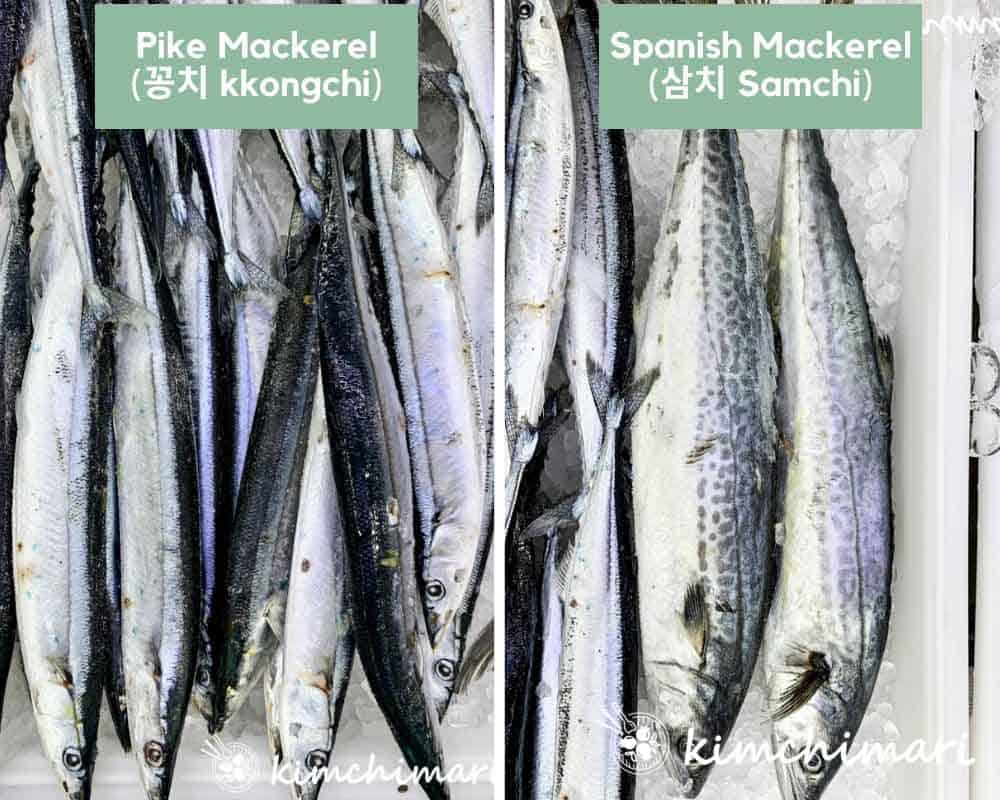What is Saury (Kkongchi) ?
Saury (Kkongchi 꽁치) also called Mackerel Pike is a small, silvery-blue fish mackerel, popular in Asian cuisine. It is high in fat and has a definite fishy taste but in a yummy way.
Koreans love having it fresh and canned and also raw as Hoe (sashimi). In the US, it is sold canned at many Korean and Asian markets, but can also be purchased fresh or frozen.
Saury has a lot of thin bones but are soft so you can eat them whole although you may prefer not to.
Not To Be Confused With
Spanish Mackerel (Samchi 삼치) and also regular Mackerel (Godeungeo 고등어) all have very similar flavor profiles and all have no scales and similarly silverish blue in color. But Kkongchi is very thin and slender than the other Mackerels. Here's a photo comparing Pike vs Spanish Mackerel.

Where and What To Buy
Korean or Asian grocery stores. Some fish markets. Can purchase fresh or canned.
When buying fresh or previously frozen, choose ones without a lot of scars on the body and with eyes that look clear and not cloudy.
For cans, there are 2 prominent brands - Penguin and Sempio. Both are similarly good so you can't go wrong with either one.
You are also likely to find pre-salted, already gutted and cleaned (often vacuum packed) Kkongchi 꽁치 in the freezer aisle.
How to Use/Cook
- Frozen or Fresh Saury is best grilled on the BBQ. If it's unsalted, gut the fish (you don't have to, you can eat the gut but is a bit bitter - some actually like this a little mixed with the meat but up to you) and split open then use Coarse Cheonilyeom to salt it a couple hours before and then BBQ on the grill. Soo yummy with some Ssam.
- Canned Saury (Kkongchi) can be simmered and made into Kkongchi Jorim which again is great to eat with Ssam. Or it can be added to Kimchi Jjigae (stew).
- Half Dried (Gwamaegi 과메기) - Originally Pacific Herring (Cheongeo 청어) was half dried to make Gwamaegi but after 1960's Pacific Herring were no longer being caught so people started to dry Saury. Gwamegi is mostly eaten in North Gyeongsang Province so it's not well known outside of the area. The fish is hung outdoors in the shade during freezing winter and goes through a freezing (mostly at night) and thawing process (during the day) which makes the flesh tender and more concentrated in flavor.
How to Clean/Store
Canned saury should be kept in a pantry that is cool, dry and away from direct sunlight. Fresh saury can be refrigerated if being used immediately, or frozen for later use.
Nutrition/Health Info
Similar to other Mackerels, Saury high levels of DHA, Vitamin E and A - all good for your health.





